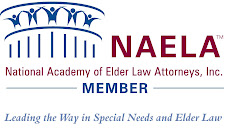When families come to see me regarding the long-term care needs of a loved one, we always identify two goals. The first, and most important goal is good quality care. The second is to obtain that care in a manner that does not completely impoverish the older person and his or her spouse. In developing a plan to pay for good care, we have to identify all sources of funds to help pay for that care. The most overlooked source of help with long-term care costs is a Veteran’s Administration (VA) benefit that pays monthly income to veterans and their spouses, and to the surviving spouses of deceased veterans. This benefit is commonly known as “Aid and Attendance Benefits.”
In 2008, an unmarried veteran can receive a cash payment of as much as $1,554 per month. A widow or widower of a deceased veteran can receive up to $998 per month. Married veterans can receive up to $1,842 per month. While this is not enough to pay for 24-hour care, it can be of great help for the senior who is still living at home or in community-based care, and needs to bring in some extra help to remain independent.
Like Medicaid, the VA Aid and Attendance benefit is a means-tested program. Generally speaking, assets have to be reduced to approximately $80,000, plus the home and one car, in order to qualify. The applicant must have limited income, however, high medical and care costs can be used to offset the applicant’s income.
In addition, the Aid and Attendance benefit is limited to wartime veterans and their spouses. The veteran does not have to have a service connected injury or have served in combat; military service during wartime for even one day is sufficient. The veteran or his or her spouse must need assistance with activities of daily living.
Even if the veteran has assets exceeding $80,000, it is possible to plan to obtain Veteran’s Aid and Attendance benefits. Unlike Medicaid, there is no five-year “penalty period” if the applicant has transferred assets out of his or her name. The eligibility rules regarding planning are not as restrictive as the Medicaid eligibility rules. By doing planning to obtain Veteran’s Benefits, it is sometimes possible to pay for care while staying out of the Medicaid system. Still, Veteran’s Benefit planning should always be done by an experienced elder law attorney who understands the Medicaid rules, just in case the veteran may someday need to qualify for Medicaid assistance.
Do you know a military veteran who served our country during wartime, and who could use some extra money to pay for care costs? If so, please give him or her a copy of this article. Planning for Veteran’s Benefits is an excellent way to provide extra income to help the veteran and his or her spouse receive the care they need, while staying independent as long as possible.
Tuesday, September 1, 2009
Salute Our Veterans With Quality Care
Subscribe to:
Post Comments (Atom)
What is keeping you awake at night?
Let us know under "Comments," 140 characters max.

Please support federal HR1522, to allow Veterans Benefits for WWII era cadet nurses. They took care of our troops, let's take care of them!
ReplyDelete